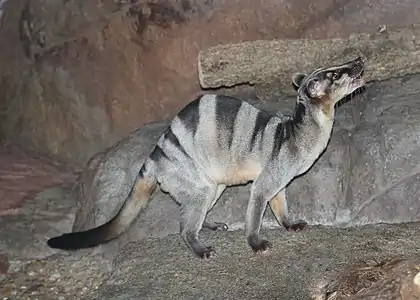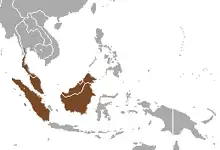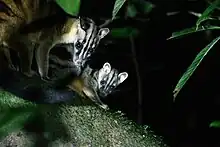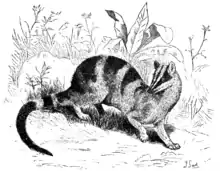Banded palm civet
The banded palm civet (Hemigalus derbyanus, Indonesian: Musang Belang[5]), also called the banded civet, is a viverrid native to Indomalaya. It inhabits primarily lowland conifer habitat, which is under threat from encroaching human activity. It is estimated the population of the banded palm civet has decreased by around 30% in just three generations. Banded palm civets are usually approximately the size of a domestic cat; their fur is pale but with dark bands on the back.
| Banded palm civet | |
|---|---|
 | |
| A banded palm civet in the Cincinnati Zoo | |
| Scientific classification | |
| Domain: | Eukaryota |
| Kingdom: | Animalia |
| Phylum: | Chordata |
| Class: | Mammalia |
| Order: | Carnivora |
| Suborder: | Feliformia |
| Family: | Viverridae |
| Genus: | Hemigalus Jourdan, 1837 |
| Species: | H. derbyanus[3] |
| Binomial name | |
| Hemigalus derbyanus[3] (Gray, 1837) | |
| Subspecies[4] | |
| |
 | |
| Banded palm civet range | |
| Synonyms | |
| |
Hemigalus derbyanus is the only species in its genus. The species comprises four subspecies, distributed across Indonesia and Southeast Asia.
Classification
The banded palm civet is the only species in the monotypic genus Hemigalus, which was first named and described by Claude Jourdan in 1837.[6][7] The genus name is derived from the Greek hemi (half) and galus (weasel), due to their appearance.[5]
The species is believed to be closely related to Hose's palm civet, another species of civet in the subfamily Hemigalinae, also distributed in Southeast Asia, with a similar build and appearance.[8]

Subspecies
There are four subspecies: H. derbyanus derbyanus, H. derbyanus boiei, H. derbyanus minor, and H. derbyanus sipora. It is estimated that H. d. minor and H. d. derbyanus diverged from each other some 2.7 million years ago.[9] H. d. derbyanus is known from Myanmar and mainland Malaysia as well as Sumatra; H. d. boiei is known only from Borneo; H. d. minor, from South Pagai and the Mentawai islands; and H. d. sipora, from Sipora and the Mentawai islands. There is also a population on Siberut island, but it has not been attributed to any subspecies.[4]
Description
The banded palm civet is roughly the size of domesticated cat, growing up to 53 centimetres (1.74 ft), minus the tail, and weighing from 1 to 3 kilograms (2.2 to 6.6 lb).[5] The tail is usually three-quarters the length of the body,[7] and may apparently swell in size when a threat is perceived. They also have sensitive hairs in between the pads of their paws for sensing prey.[10]
Their fur is usually pale in colour, with between seven and eight dark bands on the back.[10] The pale colour is typically pale brown, grey, whitish or buff, but can also be yellowish; the bands are usually dark brown, black, or chestnut in colour.[7][10][11] The banded palm civet can potentially be confused with Prionodon linsang, a related species with similar banding.[10]
One generation typically spans five years.[1] They have one or two litters a year.[5]
Distribution and habitat
According to the 2015 IUCN Red List report, the banded palm civet is found in Borneo, Sumatra, and the Malay Peninsula, as well as the smaller islands of Siberut, Sipora, and South Pagai.[1] However, they are in decline and are not found throughout their range as listed in the Red List.[10]
The banded palm civet is primarily found in lowland coniferous forests. The species' survival is probably largely dependent on forest habitat; it is not known to live in non-forested environments.[8]
Behaviour and ecology
Banded palm civets have a notably different diet than other civet species. They are known to be strict carnivores, as opposed to other civets, which are usually omnivorous.[10] They are known to prey on a variety of small animals, including crustaceans, ants, spiders, worms, rats, frogs, small reptiles, and even birds. They can only occasionally be found feeding on vegetation such as fruits.[5][10] Banded palm civets are known to hunt around water or along the forest floor.[5]
In response to a predator or other threat, banded palm civets may swell their tails,[10] or hiss and spit at the animal.[5] Reginald Innes Pocock, writing in 1939, described the civet, when captured alive, as "very savage and growls like a cat."[7]
The species is nocturnal and spends daytime in low tree holes.[5][10] They are believed to be solitary creatures.[8]
Pocock believed that the civet's striking colouration must serve some special purpose, perhaps warning of what he described as a "nauseous protective secretion of the anal glands", which is known to exist in other related genera. He also noted that while a previous writer described the animal as without any smell, he found that the secretions of the enlarged anal glands of a female specimen produced a strong odour which "reminded [him] forcefully of that of the Stoat".[7]

Conservation
The population of the species is currently decreasing.[1] The species is listed as near threatened on the IUCN Red List, and under CITES' Appendix II.[5][1][12] The major threat to the banded palm civet is habitat loss and transformation, caused by deforestation, agriculture, and plantations; as well as water damming, hunting, and logging.[1][10][8] The species' preferred habitat– lowland coniferous forest – is particularly prone to such threats.[8]
A 2022 study estimated that the civet has been reduced to just 21% of the IUCN Red List distribution, with a steep decline in population. The same paper suggested that the IUCN Red List assessment should be re-evaluated.[10] The population is believed to have declined by 30% over just three generations.[13][14]
It is absent from Singapore, where it is believed to have been extirpated in the early 20th century.[10] A 2013 study concluded that roughly 24% of the species' estimated range was in protected areas,[8] but a later (2022) study estimated that value to be only 12%.[10]
The civets are hunted and eaten locally.[1] Some humans may take them from their natural habitat to keep them as pets.[15] It is also possible the species could act as a carrier or transmitter of zoonotic disease – human infectious diseases of animal origin.[10]
The species is widespread, and is known to persist even in disrupted habitat. However, reports indicate that sightings of the banded palm civet are significantly lower in forests affected by logging.[10][8]
References
- Ross, J.; Brodie, J.; Cheyne, S.; Chutipong, W.; Hedges, L.; Hearn, A.; Linkie, M.; Loken, B.; Mathai, J.; McCarthy, J.; Ngoprasert, D.; Tantipisanuh, N.; Wilting, A.; Haidir, I.A. (2015). "Hemigalus derbyanus". IUCN Red List of Threatened Species. 2015: e.T41689A45216918. doi:10.2305/IUCN.UK.2015-4.RLTS.T41689A45216918.en. Retrieved 24 January 2022.
- "Species+". CITES.
- Wozencraft, W. C. (2005). "Species Hemigalus derbyanus". In Wilson, D. E.; Reeder, D. M. (eds.). Mammal Species of the World: A Taxonomic and Geographic Reference (3rd ed.). Johns Hopkins University Press. pp. 532–628. ISBN 978-0-8018-8221-0. OCLC 62265494.
- Veron, Géraldine; Bonillo, Céline; Hassanin, Alexandre; Jennings, Andrew P. (2017-02-23). "Molecular systematics and biogeography of the Hemigalinae civets (Mammalia, Carnivora)". European Journal of Taxonomy (285). doi:10.5852/ejt.2017.285. ISSN 2118-9773. S2CID 90409859.
 This article incorporates text from this source, which is available under the CC BY 3.0 license.
This article incorporates text from this source, which is available under the CC BY 3.0 license. - "Wildlife of RER: Banded Palm Civet". 2021-01-27. Retrieved 2023-08-16.
- Jourdan, C. (1837). "Mémoire sur deux mammifères nouveaux de l'Inde, considérés comme types des deux genres voisins des Paradoxures, genres Hémigale et Ambliodon". Comptes rendus hebdomadaires des séances de l'Académie des sciences: 442–447.
- Pocock, R. I. (1939). "Hemigalus". The fauna of British India, including Ceylon and Burma. Vol. Mammalia. – Volume 1. London: Taylor and Francis. pp. 452–458.
- Jennings, Andrew P.; Mathai, John; Brodie, Jedediah; Giordano, Anthony J.; Veron, Geraldine (2013-08-01). "Predicted distributions and conservation status of two threatened Southeast Asian small carnivores: the banded civet and Hose's civet". Mammalia. 77 (3): 261–271. doi:10.1515/mammalia-2012-0110. ISSN 1864-1547. S2CID 84601364.
- Wilting, Andreas; Sollmann, Rahel; Meijaard, Erik; Helgen, Kristofer M.; Fickel, Jörns (2012). "Mentawai's endemic, relictual fauna: is it evidence for Pleistocene extinctions on Sumatra?: Mentawai's fauna indicates extinctions on Sumatra" (PDF). Journal of Biogeography. 39 (9): 1608–1620. doi:10.1111/j.1365-2699.2012.02717.x. S2CID 86165258.
- Dunn, Ashlea; Amir, Zachary; Decoeur, Henri; Dehaudt, Bastien; Nursamsi, Ilyas; Mendes, Calebe; Moore, Jonathan H.; Negret, Pablo Jose; Sovie, Adia; Luskin, Matthew Scott (Apr 2022). "The ecology of the banded civet (Hemigalus derbyanus) in Southeast Asia with implications for mesopredator release, zoonotic diseases, and conservation". Ecology and Evolution. 12 (5): e8852. doi:10.1002/ece3.8852. ISSN 2045-7758. PMC 9047978. PMID 35505997.
- Veron, Geraldine; Laidlaw, Ruth; Rosenthal, Shelagh Heard; Streicher, Ulrike; Roberton, Scott (2004). "Coat colour variation in the banded palm civet Hemigalus derbyanus and in Owston's civet Chrotogale owstoni". Mammal Review. 34 (4): 307–310. doi:10.1111/j.1365-2907.2004.00047.x. ISSN 0305-1838.
- "First meeting of the Conference of the Parties | CITES". cites.org. Retrieved 2023-08-16.
- American Association of Zoo Keepers; Keepers, American Association of Zoo (2016). Animal keepers' forum. Vol. 43. Topeka, Kan: American Association of Zoo Keepers.
- Ross, Joanna; Hearn, Andrew; MacDonald, David W.; Semiadi, Gono; et al. (January 2016). "Predicted distribution of the banded civet Hemigalus derbyanus (Mammalia: Carnivora: Viverridae) on Borneo" (PDF). Raffles Bulletin of Zoology. 135 (3): 111–117. doi:10.1016/j.thromres.2015.01.001. PMID 25619439. S2CID 636681. Retrieved 2023-08-18.
- "Banded palm civet". indonesia.wcs.org. Retrieved 2023-08-17.
